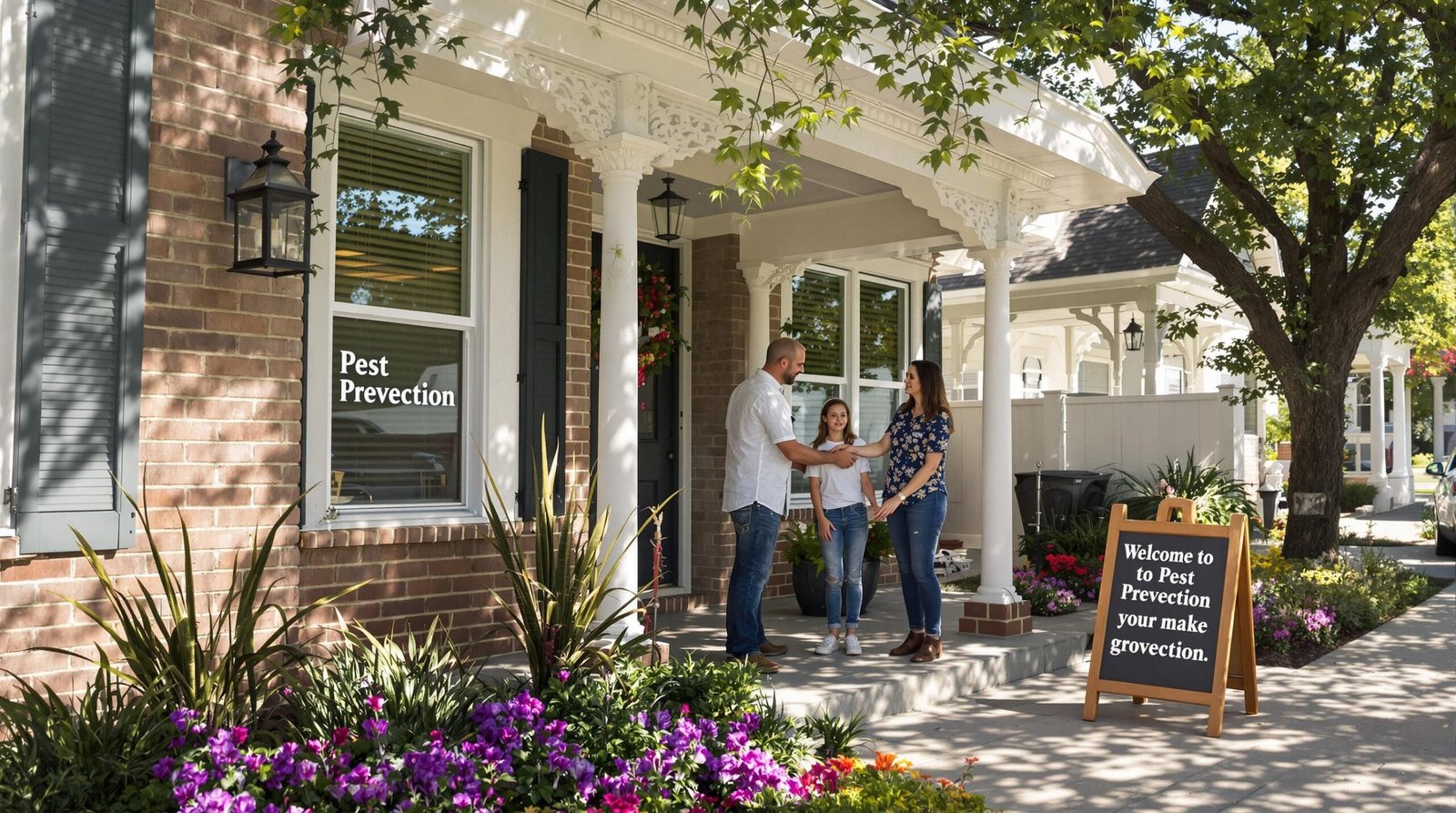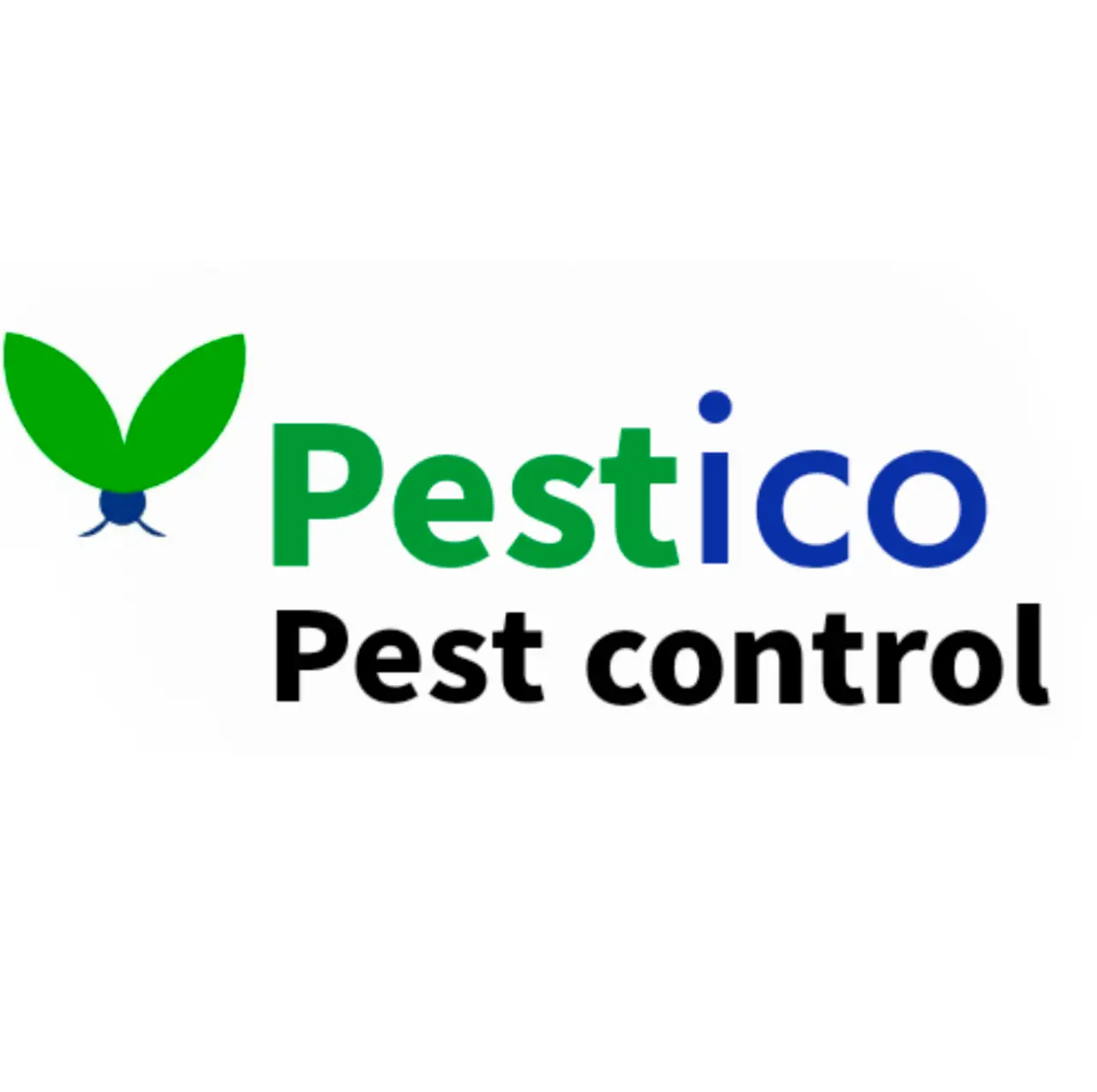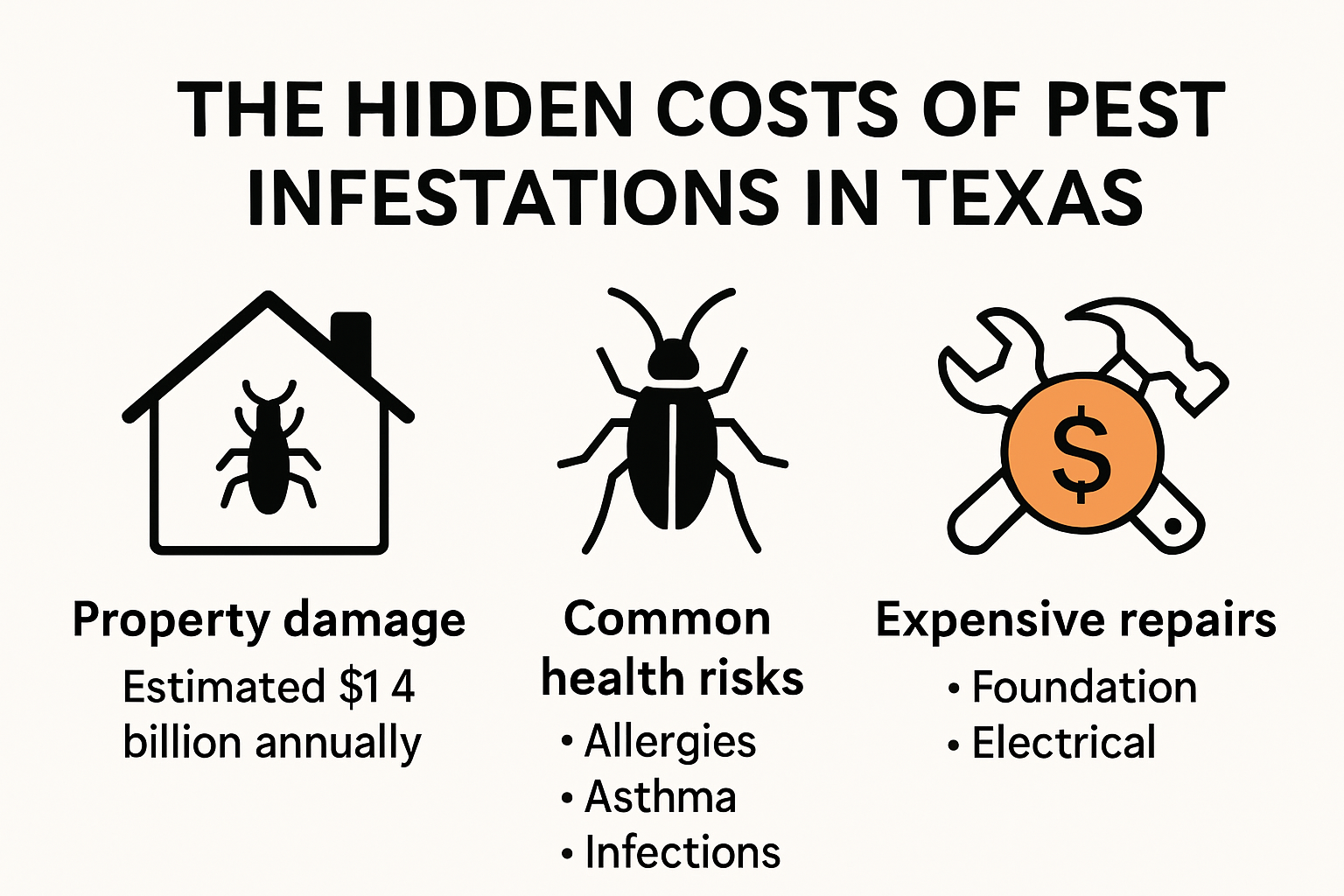
Creating a Pest Prevention Plan for Texas Homes and Businesses 2025
Texas homes and businesses face a constant battle with pests. Every year, termites alone cause over $5 billion in property damage across the United States, with Texas being especially hard hit. Most people wait until they spot trouble before taking action. That delay often leads to spiraling repair costs and ongoing headaches. Choosing a proactive prevention plan turns the tables and puts you back in control before unwelcome guests ever get in.
Table of Contents
- Why A Pest Prevention Plan Matters
- Step-By-Step Guide To Creating A Pest Prevention Plan
- Best Practices For Texas Properties
- Maintaining And Updating Your Pest Plan
Quick Summary
| Takeaway | Explanation |
|---|---|
| Create a comprehensive pest plan | A thorough assessment is essential for identifying pest entry points and risks. Regular inspections help prevent infestations before they start. |
| Implement strategic prevention techniques | Focus on sealing entry points, controlling moisture, and maintaining cleanliness to deter pests. A proactive approach is more effective than reactive treatments. |
| Schedule ongoing professional inspections | Regular expert evaluations enhance your pest management strategy, ensuring adaptability to new threats and effectiveness of current methods. |
| Adapt pest plan seasonally | Modify prevention strategies based on seasonal pest patterns and local environmental changes to maintain effectiveness and protection year-round. |
| Utilize technology and expert consultation | Leverage advanced monitoring tools and seek professional insights for a dynamic and effective pest management approach tailored to your property. |
Why a Pest Prevention Plan Matters
Pest management goes far beyond simple inconvenience in Texas homes and businesses. Creating a pest prevention plan represents a critical strategy for protecting property, health, and overall quality of life. The risks associated with unchecked pest populations extend well beyond minor discomfort, potentially causing significant structural damage, health hazards, and substantial financial investments in repairs.
The Hidden Costs of Pest Infestations
Homeowners and business owners often underestimate the potential economic impact of pest problems. According to the Environmental Protection Agency, implementing an Integrated Pest Management (IPM) approach provides safer, long-term reductions in pest populations while minimizing environmental risks. Termites alone cause over $5 billion in property damage annually in the United States, with Texas being particularly vulnerable due to its warm climate and diverse pest ecosystem.
The financial implications are staggering. Structural damage from pests like termites, carpenter ants, and rodents can compromise building integrity, leading to expensive repairs that far exceed the cost of preventative measures. Moreover, certain pests pose direct health risks. Rodents can spread diseases, cockroaches trigger allergies and asthma, and mosquitoes transmit potentially serious illnesses.
Proactive Prevention versus Reactive Treatment
Traditional pest control methods often focus on elimination after an infestation occurs. However, research demonstrates that preventative strategies are significantly more effective and cost-efficient. A comprehensive pest prevention plan involves multiple strategic approaches:
- Early Detection: Regular inspections identify potential pest entry points before they become full-blown infestations.
- Environmental Management: Reducing conditions that attract pests by controlling moisture, sealing entry points, and maintaining proper sanitation.
- Targeted Interventions: Using specific, minimal treatments tailored to identified pest risks.
For Texas homes and businesses, creating a pest prevention plan is not just recommended but essential. The state’s unique climate creates ideal breeding conditions for various pest species. Warm temperatures, humidity, and diverse landscapes provide perfect environments for insects, rodents, and other unwanted visitors.
Our comprehensive guide on pest prevention offers detailed strategies specific to Texas properties, helping residents understand and implement effective pest management techniques. By investing time and resources into proactive prevention, homeowners and business owners can protect their properties, health, and financial investments from potential pest-related challenges.
Ultimately, a well-designed pest prevention plan is more than a protective measure. It represents a smart, strategic approach to property management that delivers long-term peace of mind and substantial cost savings.
Step-by-Step Guide to Creating a Pest Prevention Plan
Developing an effective pest prevention plan requires a systematic and strategic approach tailored to the unique environmental conditions of Texas homes and businesses. The process involves comprehensive assessment, targeted interventions, and ongoing monitoring to ensure long-term protection against potential pest invasions.
Comprehensive Pest Assessment and Identification
The first critical step in creating a pest prevention plan involves a thorough property assessment. According to the Environmental Protection Agency, successful pest management begins with accurate identification of potential pest species and understanding their specific behaviors. Texas properties face unique challenges due to diverse ecological environments that support multiple pest populations.
Homeowners and business owners should conduct a detailed inspection focusing on potential entry points, moisture sources, and conditions that might attract pests. This includes examining foundation gaps, checking roof edges, inspecting window and door seals, and identifying areas with excessive moisture or organic debris. Professional pest control experts can provide comprehensive assessments that reveal hidden vulnerabilities in a property’s pest defense system.
Strategic Prevention and Control Techniques
Texas A&M University research recommends implementing Integrated Pest Management (IPM) principles that prioritize prevention over reactive treatments. Key strategies include:
- Structural Modifications: Seal potential entry points such as cracks in foundations, gaps around utility lines, and damaged window screens.
- Environmental Management: Reduce moisture accumulation, maintain proper landscape drainage, and minimize organic debris near structures.
- Regular Maintenance: Implement consistent cleaning protocols, store food in sealed containers, and manage garbage effectively.
The goal is creating multiple layers of defense that discourage pest populations from establishing themselves. This approach minimizes the need for chemical interventions and provides a more sustainable long-term solution.
Ongoing Monitoring and Professional Consultation
Successful pest prevention is not a one-time event but a continuous process requiring regular monitoring and adaptation. Property owners should schedule periodic professional inspections to assess the effectiveness of their prevention strategies. Learn more about managing pest complaints and treatments to understand the nuanced approaches required for different pest scenarios.
Professional pest control experts can provide customized recommendations based on specific property characteristics, local pest populations, and seasonal variations. They can help develop a dynamic prevention plan that evolves with changing environmental conditions and emerging pest threats.
By following a structured, proactive approach to pest prevention, Texas homeowners and business owners can protect their properties from potential damage, health risks, and costly infestations. The investment in a comprehensive prevention plan pays dividends through reduced repair costs, improved property conditions, and peace of mind.
Best Practices for Texas Properties
Texas properties require specialized pest prevention strategies that address the state’s unique environmental challenges. The combination of warm temperatures, diverse landscapes, and varied ecological zones creates perfect conditions for multiple pest species to thrive. Implementing targeted best practices can significantly reduce the risk of pest infestations and protect residential and commercial properties.
Structural Protection and Environmental Management
According to the U.S. Environmental Protection Agency, effective pest prevention begins with eliminating potential food, water, and shelter sources. For Texas properties, this means taking comprehensive approaches to structural protection. The Building America Solution Center recommends specific strategies tailored to regional conditions:
- Landscape Modifications: Maintain at least 6 feet of clearance between exterior walls and tree limbs to prevent pest access.
- Foundation Protection: Use crushed stone or pea gravel around building foundations instead of wood mulch to deter pest migration.
- Moisture Control: Address drainage issues, fix leaky plumbing, and ensure proper ventilation to reduce attractive environments for pests.
Special attention must be paid to sealing potential entry points. Texas A&M University’s Integrated Pest Management research emphasizes the importance of closing openings larger than 1/4 inch in foundations, walls, and roofs to prevent rodent intrusion.
To clarify and organize the main strategies discussed in this section, the table below summarizes structural and environmental best practices for Texas properties:
| Prevention Area | Key Best Practice | Purpose |
|---|---|---|
| Landscape Modifications | 6 ft clearance between walls & trees | Prevent pest access to buildings |
| Foundation Protection | Use crushed stone or pea gravel, not wood mulch | Discourage pest migration at foundations |
| Moisture Control | Fix drainage issues, leaks, ensure proper ventilation | Reduce attractive environments for pests |
| Entry Point Sealing | Close foundation/wall/roof gaps > 1/4 inch | Stop rodents and insects from entering |
Seasonal Pest Prevention Strategies
Texas experiences unique seasonal pest challenges that require adaptive prevention techniques. Summer months bring increased insect activity, while winter can drive rodents and other animals seeking warmth indoors. Homeowners and business owners should implement seasonal-specific strategies:
- Rotate outdoor garbage containers away from building structures
- Remove standing water that can become breeding grounds for mosquitoes
- Trim vegetation regularly to reduce potential pest habitats
- Store firewood at least 20 feet from buildings
- Inspect outdoor furniture and equipment for potential pest nesting sites
Explore our comprehensive home pest prevention checklist for detailed guidance on protecting your Texas property throughout the year.
Professional Assessment and Ongoing Maintenance
While property owners can implement many preventive measures, professional pest control expertise remains crucial. Regular professional inspections can identify potential vulnerabilities before they become significant problems. Experts understand local pest behaviors, can recognize early warning signs, and provide tailored recommendations specific to individual property characteristics.
Texas properties benefit from a proactive approach that combines DIY prevention techniques with professional monitoring. This strategy involves:
- Quarterly professional inspections
- Customized treatment plans
- Ongoing education about emerging pest threats
- Implementation of environmentally responsible control methods
By adopting these best practices, Texas property owners can create robust defense systems against potential pest invasions. The key lies in understanding local ecological conditions, implementing strategic preventive measures, and maintaining consistent monitoring and maintenance protocols.
Ultimately, successful pest prevention is about creating an inhospitable environment for unwanted visitors while maintaining the health and integrity of residential and commercial spaces.
Maintaining and Updating Your Pest Plan
A pest prevention plan is not a static document but a dynamic strategy that requires continuous evaluation and adaptation. For Texas properties, maintaining an effective pest management approach means staying proactive, responsive, and informed about changing environmental conditions and emerging pest challenges.
Regular Monitoring and Assessment
The U.S. Environmental Protection Agency emphasizes that successful Integrated Pest Management (IPM) relies on consistent monitoring and strategic updates. Homeowners and business owners should implement a systematic approach to tracking pest activity, which includes:
- Quarterly professional inspections
- Monthly self-assessments of property vulnerabilities
- Documentation of any pest sightings or potential entry points
- Tracking seasonal changes that might impact pest populations
Texas A&M AgriLife Extension Service recommends creating a comprehensive log that records pest activities, treatment responses, and environmental factors. This documentation helps identify patterns and develop more targeted prevention strategies.
To help property owners understand the regular monitoring schedule, the table below outlines suggested intervals and tasks:
| Frequency | Monitoring Task | Description |
|---|---|---|
| Quarterly | Professional inspection | Comprehensive pest risk assessment |
| Monthly | Self-assessment of vulnerabilities | Check for new entry points, moisture, etc. |
| As needed | Document pest sightings/entry points | Record location, time, and pest type |
| Seasonally | Track environmental/pest population changes | Note weather changes or increased pest activity |
Adaptive Prevention Strategies
Texas properties face unique challenges due to diverse ecological zones and rapidly changing climate conditions. The City of Austin’s Integrated Pest Management program suggests developing flexible prevention strategies that can quickly adapt to new circumstances.
Key considerations for updating your pest prevention plan include:
- Reviewing and modifying entry point sealing techniques
- Adjusting landscape management based on seasonal changes
- Updating moisture control methods
- Reassessing potential food and shelter sources for pests
Check out our monthly pest inspection checklist to streamline your ongoing pest management efforts and ensure comprehensive coverage.
Professional Consultation and Technology Integration
Technology and professional expertise play crucial roles in maintaining an effective pest prevention plan. Modern pest management increasingly relies on advanced monitoring techniques, including:
- Smart sensors that detect early signs of pest activity
- Digital tracking systems for pest population trends
- Advanced moisture and temperature monitoring tools
- Geographic information systems (GIS) for regional pest mapping
Professional pest control experts can provide invaluable insights into emerging pest threats, recommend technology-driven solutions, and help property owners stay ahead of potential infestations. They bring specialized knowledge about local pest behaviors, environmental interactions, and the most effective prevention techniques.
Successful pest prevention in Texas requires a commitment to continuous learning and adaptation. By maintaining a flexible, technology-enhanced approach and working with professional experts, property owners can create robust defense systems that protect their investments and maintain healthy living environments.
Remember that an effective pest prevention plan is not about perfection but about consistent, informed management. Regular assessment, willingness to adapt, and proactive strategies are the keys to long-term pest control success.
Frequently Asked Questions
What is a pest prevention plan?
A pest prevention plan is a proactive strategy designed to identify and mitigate potential pest infestations before they occur. It involves regular assessments, strategic interventions, and ongoing monitoring tailored to the specific needs of your property.
Why is pest prevention especially important in Texas?
Texas has a warm climate and diverse ecosystems that create ideal conditions for various pests, such as termites and rodents. A pest prevention plan is essential to protect properties from significant structural damage and health risks associated with pest infestations.
How can I create an effective pest prevention plan for my home or business?
Start by conducting a comprehensive pest assessment of your property, identifying potential entry points and moisture sources. Implement strategic prevention techniques, such as sealing gaps, managing the environment, and scheduling regular professional inspections to monitor and adapt your plan over time.
What are some best practices for pest prevention in Texas?
Best practices include sealing entry points, managing moisture levels, maintaining cleanliness, implementing seasonal strategies, and utilizing professional pest control services for ongoing monitoring and assessments. This multi-layered approach helps deter pests and reduces the likelihood of infestations.
Take Control With Local Pest Prevention Experts for Texas Homes and Businesses
Is your Texas property at risk of costly pest damage or recurring infestations? If the thought of hidden termite destruction, dangerous rodents, or relentless mosquitoes keeps you worried, you are not alone. As explained in our article, delaying action only leads to more repairs and health concerns. Now is the time to put proven prevention strategies in place and make sure your family, customers, and investments are protected.
Let Pestico’s local team help you build a customized pest prevention plan designed for the unique challenges of Texas. We offer affordable and thorough pest, termite, mosquito, and rodent solutions that follow the very same Integrated Pest Management principles shared in our home pest prevention checklist.
Visit pestico.biz now to request your expert inspection or learn more about our home protection strategies. Take the first step today and let us help you keep pests away for good.
Recommended
- 2025 Home Pest Prevention Checklist For Texas Residents – Pest Control Van Alstyne, TX – Pestico Pest Control
- Pest Control Scheduling Guide 2025 For Texas Homeowners & Businesses – Pest Control Van Alstyne, TX – Pestico Pest Control
- Pest Control Regulations Texas 2025 – Pest Control Van Alstyne, TX – Pestico Pest Control
- DIY Pest Prevention Tips – Pest Control Van Alstyne, TX – Pestico Pest Control
- Apartment Cleaning Advice for Collin County in 2025
- HVAC Emergency Preparation Guide 2025 for Louisville & Southern Indiana – HVAC Service and Repair | Louisville, KY | Project Heating & Cooling



